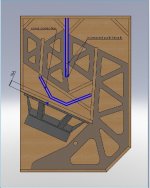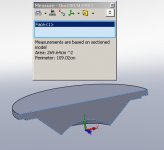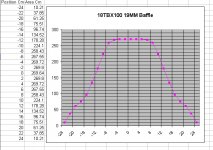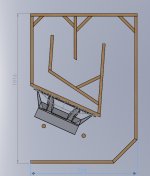Just waiting for the weather to clear then I'll get you some new measurements, this time with the 18NLW9000 and a new measurement mic calibrated down to 10Hz. I already had a little listening test with the 9000 and it at least sounds like a BIG improvement compared to the 18NW100 
I been busy making some other things but I'll try to make some of your changes to the TH18 and test it later on. I'm really interested in the cone volume correction mods. So if I understand correctly the problem with the current TH-18 design is cone control at high power levels and this should help fix this? Just so I know what kind of tests I should do.
I been busy making some other things but I'll try to make some of your changes to the TH18 and test it later on. I'm really interested in the cone volume correction mods. So if I understand correctly the problem with the current TH-18 design is cone control at high power levels and this should help fix this? Just so I know what kind of tests I should do.
Last edited:
Hi Everyone
I made a start on measuring the cross sectional areas across various sections through the speaker driver. It immediately becomes apparent that the area is virtually constant over a distance roughly related to the diameter of the dust cap.
This means that the shape of the cone correction should have a flatttened area not just a V point as DJims last suggestion here
http://www.diyaudio.com/forums/subw...30-ft30-pa-th-awesomeness-72.html#post3017801
When we add this to Arts comment in post 528
http://www.diyaudio.com/forums/subwoofers/190635-th-18-flat-35hz-xoc1s-design-53.html#post2936917
it makes more sense.
If we put all these observations together what we end up with with the TH18 / SS15 folding is something like the attached sketch.
Regards Xoc 1
I made a start on measuring the cross sectional areas across various sections through the speaker driver. It immediately becomes apparent that the area is virtually constant over a distance roughly related to the diameter of the dust cap.
This means that the shape of the cone correction should have a flatttened area not just a V point as DJims last suggestion here
http://www.diyaudio.com/forums/subw...30-ft30-pa-th-awesomeness-72.html#post3017801
When we add this to Arts comment in post 528
http://www.diyaudio.com/forums/subwoofers/190635-th-18-flat-35hz-xoc1s-design-53.html#post2936917
it makes more sense.
If we put all these observations together what we end up with with the TH18 / SS15 folding is something like the attached sketch.
Regards Xoc 1
Attachments
When we add this to Arts comment in post 528
http://www.diyaudio.com/forums/subwoofers/190635-th-18-flat-35hz-xoc1s-design-53.html#post2936917
it makes more sense.
If we put all these observations together what we end up with with the TH18 / SS15 folding is something like the attached sketch.
Regards Xoc 1
And here I thought at the time -- I was being clever on my folding for the ss15....... ah well....
Hi Martin,This means that the shape of the cone correction should have a flatttened area not just a V point as DJims last suggestion here
http://www.diyaudio.com/forums/subw...30-ft30-pa-th-awesomeness-72.html#post3017801
True, but in practice we didn't notice much of a difference. We just rounded the point a little by the thickness of the panels, to prevent turbulence.
Another mind buster for you, how you are going to correct the wavelength differences between the left side and right side of the driver? (and the wrong positionned S2 point). Cone correction cannot be used above an S-shaped throat and the V correction makes the difference between the sides even worse... Just a small reminder, other drivers in the Danley TH18 didn't seem to have a long life time
(Edit: we tested V-shape cone corrections only in the symmetric folding lay-outs that don't have a S2 issue...)
Last edited:
Hi mRgSr,Is that why they switched from the 18sound 9600 to the b&c 18sw115?
You have to ask Danley. If that was the reason or not there were mechanical issues with the first generation 9600's that have been solved.
Hi All
Analysis of the cross sectional area of a 18TBX100 on a 19mm baffle with a 48.3cm dia cutout. The first pic shows the section measured at the centre position, Zero in the spreadsheet. The second pic shows the spreadsheet of the areas every 2 cm across the speaker cone.
The graph shows the shape.
Regards
Xoc1
Analysis of the cross sectional area of a 18TBX100 on a 19mm baffle with a 48.3cm dia cutout. The first pic shows the section measured at the centre position, Zero in the spreadsheet. The second pic shows the spreadsheet of the areas every 2 cm across the speaker cone.
The graph shows the shape.
Regards
Xoc1
Attachments
The sketch is closer to "almost exactly" than "something like" the DSL TH-115.When we add this to Arts comment in post 528
http://www.diyaudio.com/forums/subwoofers/190635-th-18-flat-35hz-xoc1s-design-53.html#post2936917
it makes more sense.
If we put all these observations together what we end up with with the TH18 / SS15 folding is something like the attached sketch.
Regards Xoc 1
Loose some of those volume robbing corner ramps you are so fond of and it would be even closer
Art
That looks neat but your cone is not drawn correctly?
I really should re-check my posts befor posting!
The dimensions of the cone are based on the B&C 18SW115 info from TundraLTD given here
http://www.diyaudio.com/forums/subwoofers/190635-th-18-flat-35hz-xoc1s-design-53.html#post2936329
He was the only person who answered my request for dimensional data
Anyway areas calculated and added to TH18 sketch to help calculate an adjusted throat.
Attachments
I see what you have now, that makes better sense.
Well if there is going to be a flat centered over the driver as proposed here:
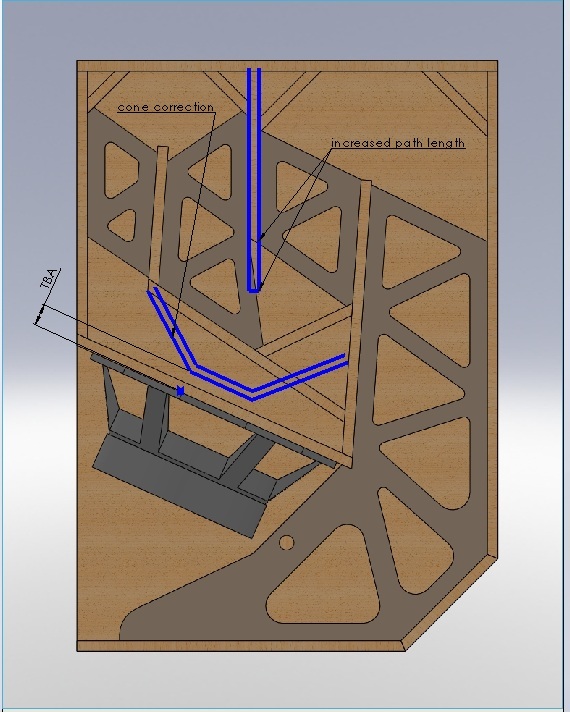
If the V cut out for "cone control" seems unappealing and or you feel the need to deviate a bit to separate the DIY from the commercial design - why not make use of the scrap from the driver cutout and make a loading disc centered on the driver? I think it could potentially be the method to produce the most even load on the cone.?
Well if there is going to be a flat centered over the driver as proposed here:

If the V cut out for "cone control" seems unappealing and or you feel the need to deviate a bit to separate the DIY from the commercial design - why not make use of the scrap from the driver cutout and make a loading disc centered on the driver? I think it could potentially be the method to produce the most even load on the cone.?
You are suggesting this  ?
?
An example of a simple cone correction made out disks cut from sheets:
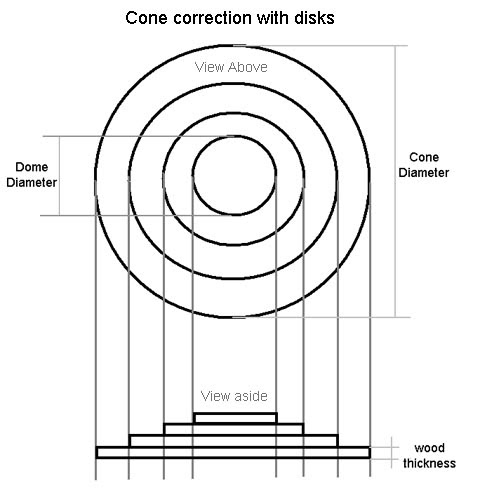
To make it fit for the 6-Fold you need to cut out a piece:
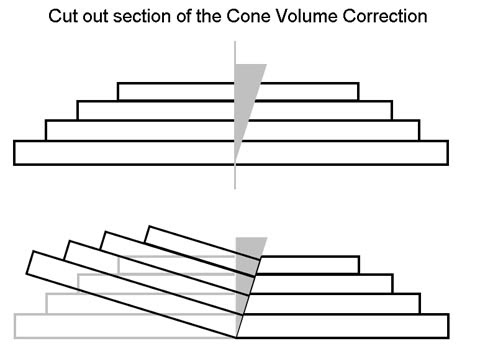
You can cut out rings instead of full disks to save weight...
Probably a single flat disc as the cone correction is now incorporated into the horns path and the more layers you add the more path length you have to give up.You are suggesting this?
Actually now that I think about it your suggestion of a ring would make the most sense as it will displace the least volume and allow for the longer path length. I would make it a optional add in for the test cabinet.
Last edited:
The sketch is closer to "almost exactly" than "something like" the DSL TH-115.
Loose some of those volume robbing corner ramps you are so fond of and it would be even closer.
Art
Art
When I started this design process I had no idea of Tom Danleys designs apart from the information that Mr Danley had made freely available.
The size envelope was used as as given the performance of the DSL TH115 / 118 enclosures this is obviously big enough to work well.
The folding was purely based on JBells SS15 and DIYaudio based work on horn geometry.
As the user builds have shown although the design works well enough up to a limit of say 1.6KW the speaker is lacking in ultimate control at elevated power levels that the best drivers are capable of.
Though the course of development and discussion of the tapped horns on DIYaudio we eventally stumbled across a horn throat, which as you described it contains Mr Danley's 'Secret Sauce'.
Well the cats out the bag and theres no way of putting it back!
The layout of the Danley TH115 /118 is I guess exactly as you have described.
Question is what am i supposed to do?
I could just post an updated clone layout without any technical explanation.
I could just drop the whole project.
Or I could try to take onboard the advances on TH design that we have discovered, and try to present them in a valid and techinical manner so that we can try to learn something from them.
I am very hesitant about this, but I think that if we can make sense of the process of improving the horn throat then that technique can be used in other TH variants.
Regards
Xoc1 (Martin)
Art
When I started this design process I had no idea of Tom Danleys designs apart from the information that Mr Danley had made freely available.
The size envelope was used as as given the performance of the DSL TH115 / 118 enclosures this is obviously big enough to work well.
The folding was purely based on JBells SS15 and DIYaudio based work on horn geometry.
As the user builds have shown although the design works well enough up to a limit of say 1.6KW the speaker is lacking in ultimate control at elevated power levels that the best drivers are capable of.
Though the course of development and discussion of the tapped horns on DIYaudio we eventally stumbled across a horn throat, which as you described it contains Mr Danley's 'Secret Sauce'.
Well the cats out the bag and theres no way of putting it back!
The layout of the Danley TH115 /118 is I guess exactly as you have described.
Question is what am i supposed to do?
I could just post an updated clone layout without any technical explanation.
I could just drop the whole project.
Or I could try to take onboard the advances on TH design that we have discovered, and try to present them in a valid and techinical manner so that we can try to learn something from them.
I am very hesitant about this, but I think that if we can make sense of the process of improving the horn throat then that technique can be used in other TH variants.
Regards
Xoc1 (Martin)
My 2c on this.
I have never seen nor heard a danley sub. Art's got a leg up on me there. I am very respectful of IP and don't want to in any way infringe on Tom's work. To that end, I don't think I'd like an exact copy of anyone else's work... I would like it to always be my own. I like what NeoDan has shown a couple posts up. I think I can accomplish that within the single sheet design limitation that I placed on myself for the SS15. However, true 'cone correction' that DJIM and others are working on -- if that is truly the final bit of secret sauce... I think I'd prefer to leave it secret. If I can get a bit more low by having a slightly longer path, and a little bit better cone control by having a slightly better throat -- that sounds good to me...
I applaud the efforts and learning on this, but I don't have to have, or want... "exact."
Cone Volume Correction can restore part of the low end in some situations where the low end in an actual build seems to be less compared to its theoretical HornResp model. It is nothing new and is used since the beginning of horn design. Therefore it is not Danley exclusive. In my (many ) attempts to improve the notorious Jbell SS15 I first mentioned it, more than a year ago, with a drawing concept that includes very similar folding style. Since than I have mentioned it in several posts and Art was the only one asking me specific questions about it, half a year ago.
) attempts to improve the notorious Jbell SS15 I first mentioned it, more than a year ago, with a drawing concept that includes very similar folding style. Since than I have mentioned it in several posts and Art was the only one asking me specific questions about it, half a year ago.
That the Xoc1-TH18 becomes more and more a look-Danley-alike is not strange at all. Physics and building limitation force you to use it in the panel facing the driver. That means not many options are left, besides making it more complex than necessary. Using it as part of the folding is therefore nothing more than logic.
IF* any ethical line is passed, it is not the inclusion of Cone Volume Correction or folding techniques that are both the result of physics and old horn techniques but it is designing tapped horns in the first place.
(* = everybody should answer that question for himself since I am not here to judge anyone, but Danley didn't seem to have a problem with sharing all information and has been correcting people in the DIY community with additional info)
That the Xoc1-TH18 becomes more and more a look-Danley-alike is not strange at all. Physics and building limitation force you to use it in the panel facing the driver. That means not many options are left, besides making it more complex than necessary. Using it as part of the folding is therefore nothing more than logic.
IF* any ethical line is passed, it is not the inclusion of Cone Volume Correction or folding techniques that are both the result of physics and old horn techniques but it is designing tapped horns in the first place.
(* = everybody should answer that question for himself since I am not here to judge anyone, but Danley didn't seem to have a problem with sharing all information and has been correcting people in the DIY community with additional info)
Last edited:
Design done independently is still your design. There is no patent on the fold geometry. Your independent work is documented on this thread. What do you have to worry about?
Second point is that the tapped horn concept is not an invention of Tom Danley. It has been popularized by his work with them.
Second point is that the tapped horn concept is not an invention of Tom Danley. It has been popularized by his work with them.
Thanks for the confirmation guys... I appreciate it. I also work in the software industry where protection of IP is not just the thing.. it's almost the only thing. That makes me extremely sensitive to it.
Clean Room Engineering is always safe, blatant reverse engineering or copying is not. (having clues from Art on how close to "exact" is kinda a grey area though... and is currently my personal issue on what I do with that information....)
I don't personally feel like to this point I have crossed any IP boundaries with my designs.
I have always made sure to do my own work, my own testing, and at the end of the day, I know I have something that is truly mine. As a benefit to those that freely share with me, I share in return.
I've tried circular, triangular, and S shaped openings in front of the driver, with various effects. Are any of these new? no.. Is a particular application of them in a TH style cabinet infringing? no. Knowing a production detail from someone else's work, and trying to replicate it... hmmm.. This would be an easier conversation for me without Art's comment.
so, I don't see any issue with pursuing this line of thinking, building, and testing. I just think that those with personal knowledge of protected designs, should be very careful about providing too much detail... so that everyone can feel comfortable knowing they are doing their own work....
Clean Room Engineering is always safe, blatant reverse engineering or copying is not. (having clues from Art on how close to "exact" is kinda a grey area though... and is currently my personal issue on what I do with that information....)
I don't personally feel like to this point I have crossed any IP boundaries with my designs.
I have always made sure to do my own work, my own testing, and at the end of the day, I know I have something that is truly mine. As a benefit to those that freely share with me, I share in return.
I've tried circular, triangular, and S shaped openings in front of the driver, with various effects. Are any of these new? no.. Is a particular application of them in a TH style cabinet infringing? no. Knowing a production detail from someone else's work, and trying to replicate it... hmmm.. This would be an easier conversation for me without Art's comment.
so, I don't see any issue with pursuing this line of thinking, building, and testing. I just think that those with personal knowledge of protected designs, should be very careful about providing too much detail... so that everyone can feel comfortable knowing they are doing their own work....
- Home
- Loudspeakers
- Subwoofers
- TH-18 Flat to 35hz! (Xoc1's design)
